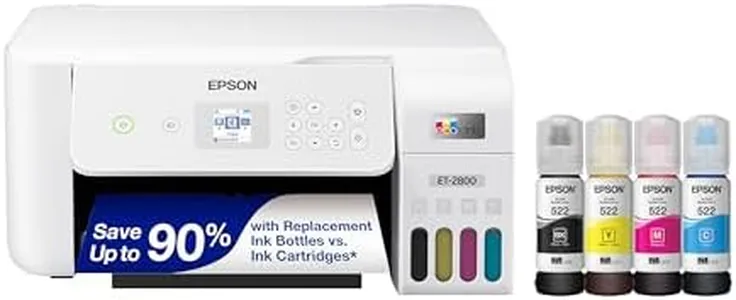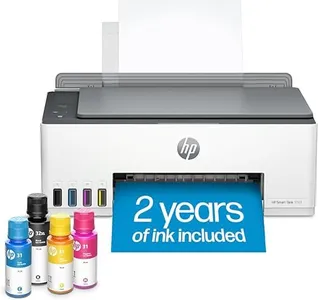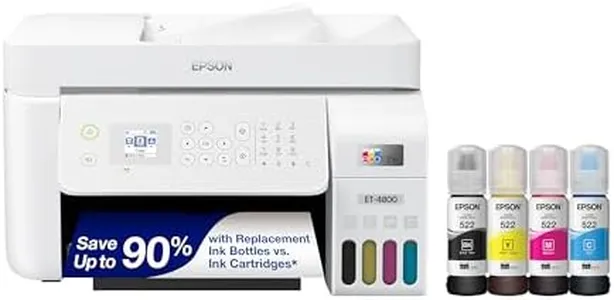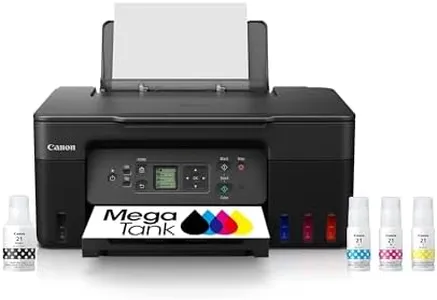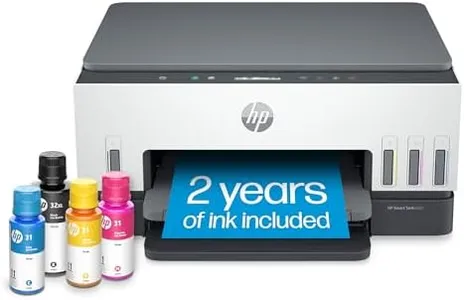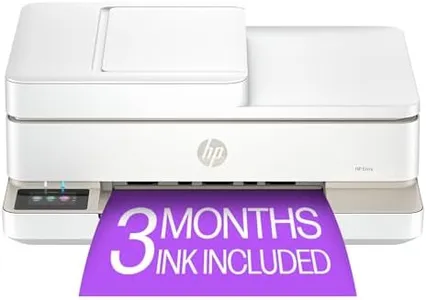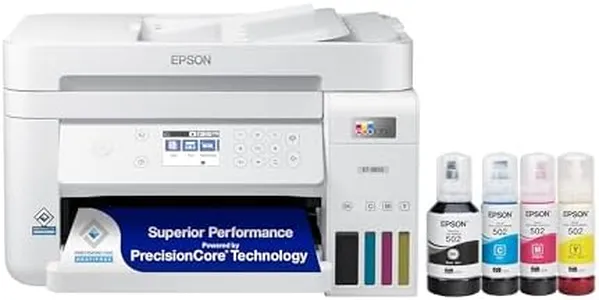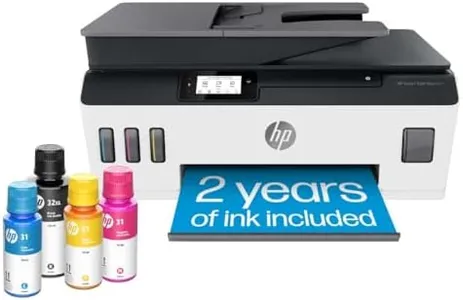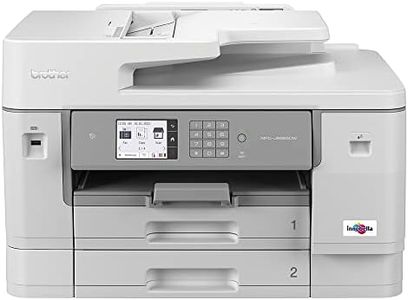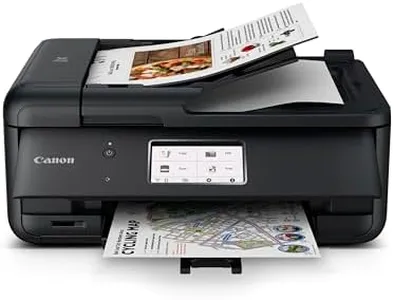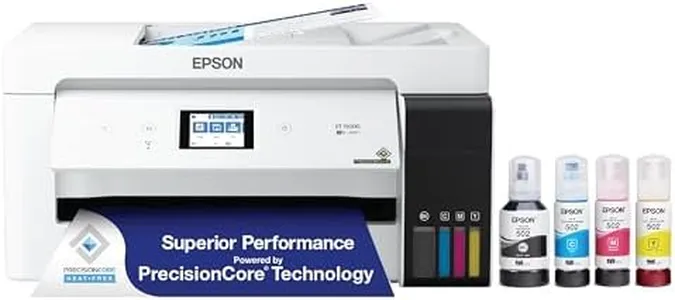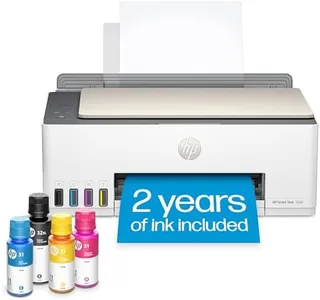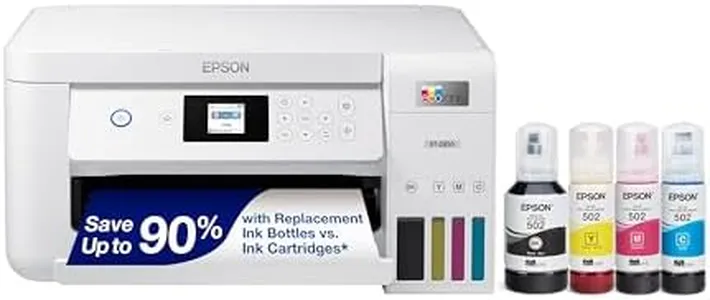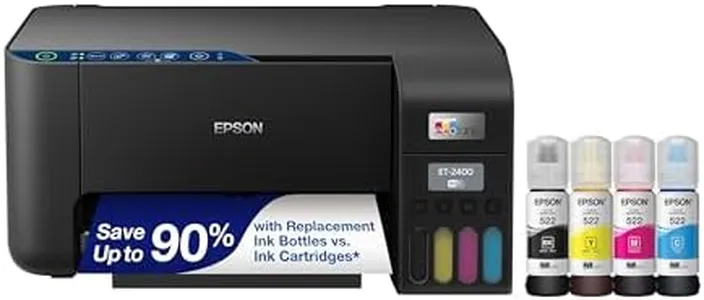10 Best Printer With Ink Tank System 2025 in the United States
Our technology thoroughly searches through the online shopping world, reviewing hundreds of sites. We then process and analyze this information, updating in real-time to bring you the latest top-rated products. This way, you always get the best and most current options available.

Our Top Picks
Winner
Epson EcoTank ET-2800 Wireless Color All-in-One Cartridge-Free Supertank Printer with Scan and Copy – The Ideal Basic Home Printer - White, Medium
The Epson EcoTank ET-2800 is an excellent choice for anyone in need of a basic home printer, especially those looking for cost-effective ink solutions. Its innovative ink tank system eliminates the need for traditional cartridges, allowing for dramatic savings on replacement ink – up to 90% compared to standard cartridges. This printer comes with enough ink to last up to two years, with the capacity to print a substantial 4,500 black and 7,500 color pages, making it ideal for families or small home offices with moderate printing needs.
Print quality is impressive, thanks to Epson's Micro Piezo technology, producing sharp text and vibrant images on various paper types. The built-in scanner and copier add versatility, allowing for easy document handling and navigation through its color display. Connectivity options, including wireless capabilities, make it user-friendly for mobile printing.
There are a few considerations. The print speed might be slower than some might expect, at 10 pages per minute for black and only 5 for color. Additionally, duplex printing is manual, which could be cumbersome for users who frequently need double-sided documents. The printer's weight of 8.8 pounds might make it less portable for those seeking to move it around frequently. In terms of paper handling, it has a maximum input capacity of 100 sheets, which is reasonable but may not suffice for heavier users. While the EcoTank system is a huge plus in terms of waste reduction, it’s essential to ensure you have the right space for refilling the tanks. For those looking for a reliable, economical printer for home use, the EcoTank ET-2800 stands out, but it may not suit those with high-volume printing needs or who require faster speeds.
Customer Highlights
A summary of real customer reviews to highlight what shoppers are saying!HP Smart Tank 5101 Wireless All-in-One Ink Tank Printer with 2 years of ink included,Print, scan, copy, Best-for-home, Refillable ink tank (1F3Y0A)
The HP Smart Tank 5101 is a versatile all-in-one printer ideal for home use, particularly for families needing to print high volumes of color documents. One of its standout features is the inclusion of 2 years' worth of ink, allowing for up to 6,000 pages, which is highly cost-effective. The print quality is commendable, with resolutions of up to 4800 x 1200 dpi for color prints, ensuring vivid, true-to-life photos and crisp text. However, its print speed is moderate, with 12 pages per minute (ppm) for black and 5 ppm for color, which may be slower than some users expect.
Additionally, while it supports duplex printing, it requires manual intervention, which may be inconvenient for those needing automatic double-sided printing. The ink tank system is easy to refill without spills, making maintenance hassle-free. Connectivity is another strong point, featuring wireless and USB options, along with a reliable self-healing Wi-Fi.
The HP app enhances usability, allowing mobile printing, scanning, and copying directly from smartphones. Security features like basic encryption and password protection add a layer of safety for your data. On the downside, the printer’s paper handling is limited to a 100-sheet input capacity, which might be restrictive for high-volume users. Replacement ink costs are generally lower compared to traditional cartridges, thanks to the refillable tank system. The HP Smart Tank 5101 is best suited for home users who prioritize cost-effective, high-volume printing and are comfortable with manual duplex printing.
Customer Highlights
A summary of real customer reviews to highlight what shoppers are saying!Epson EcoTank ET-4800 Wireless All-in-One Cartridge-Free Supertank Printer with Scanner, Copier, Fax, ADF and Ethernet – Ideal-for Your Home Office, White
The Epson EcoTank ET-4800 printer is designed for home office use and shines in the ink tank printer category, mainly due to its innovative cartridge-free printing system. One of its biggest strengths is the high-capacity ink tanks that significantly reduce the cost of replacement ink, promising savings of up to 90% compared to traditional cartridges. With enough ink to print up to 4,500 black and 7,500 color pages, it provides a long printing lifespan before needing a refill, making it ideal for users who print frequently. The print quality is impressive, utilizing Micro Piezo technology to produce sharp text and vibrant colors, suitable for both documents and photos. Additionally, it includes features like duplex printing and a built-in scanner and copier, enhancing its functionality as an all-in-one device.
On the connectivity front, the EcoTank ET-4800 offers Ethernet and wireless options, allowing for easy printing from various smart devices. The voice-activated printing adds a modern touch to its usability. However, it has some limitations worth noting. The print speed, at 10 pages per minute for black and 5 for color, may not satisfy those in need of rapid output for large print jobs. The size of the printer could also be a consideration if space is limited. Furthermore, while the warranty is robust, using non-genuine ink may void it, which could be a drawback for some cost-conscious users.
The Epson EcoTank ET-4800 serves as an excellent choice for home office users seeking economical and high-quality printing solutions, though it may not be the best fit for those who prioritize speed over other features.
Customer Highlights
A summary of real customer reviews to highlight what shoppers are saying!Buying Guide for the Best Printer With Ink Tank System
Choosing the right printer with an ink tank system can be a game-changer for your printing needs, especially if you print frequently. Ink tank printers are known for their cost-efficiency and high-volume printing capabilities. To make an informed decision, you need to consider several key specifications that will determine how well the printer meets your needs. Understanding these specs will help you navigate through the options and select the best fit for you.FAQ
Most Popular Categories Right Now
